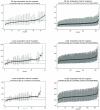Repeat surgery after lumbar decompression for herniated disc: the quality implications of hospital and surgeon variation
- PMID: 22193055
- PMCID: PMC3299929
- DOI: 10.1016/j.spinee.2011.11.010
Repeat surgery after lumbar decompression for herniated disc: the quality implications of hospital and surgeon variation
Abstract
Background context: Repeat lumbar spine surgery is generally an undesirable outcome. Variation in repeat surgery rates may be because of patient characteristics, disease severity, or hospital- and surgeon-related factors. However, little is known about population-level variation in reoperation rates.
Purpose: To examine hospital- and surgeon-level variation in reoperation rates after lumbar herniated disc surgery and to relate these to published benchmarks.
Study design/setting: Retrospective analysis of a discharge registry including all nonfederal hospitals in Washington State.
Methods: We identified adults who underwent an initial inpatient lumbar decompression for herniated disc from 1997 to 2007. We then performed generalized linear mixed-effect logistic regressions, controlling for patient characteristics and comorbidity, to examine the variation in reoperation rates within 90 days, 1 year, and 4 years.
Results: Our cohort included 29,529 patients with a mean age of 47.5 years, 61% privately insured, and 15% having any comorbidity. The age-, sex-, insurance-, and comorbidity-adjusted mean rate of reoperation among hospitals was 1.9% at 90 days (95% confidence interval [CI], 1.2-3.1), with a range from 1.1% to 3.4%; 6.4% at 1 year (95% CI, 3.9-10.6), with a range from 2.8% to 12.5%; and 13.8% at 4 years (95% CI, 8.8-19.8), with a range from 8.1% to 24.5%. The adjusted mean reoperation rates of surgeons were 1.9% at 90 days (95% CI, 1.4-2.4) with a range from 1.2% to 4.6%, 6.1% at 1 year (95% CI, 4.8-7.7) with a range from 4.3% to 10.5%, and 13.2% at 4 years (95% CI, 11.3-15.5) with a range from 10.0% to 19.3%. Multilevel random-effect models suggested that variation across surgeons was greater than that of hospitals and that this effect increased with long-term outcomes.
Conclusions: Even after adjusting for patient demographics and comorbidity, we observed a large variation in reoperation rates across hospitals and surgeons after lumbar discectomy, a relatively simple spinal procedure. These findings suggest uncertainty about indications for repeat surgery, variations in perioperative care, or variations in quality of care.
Copyright © 2012 Elsevier Inc. All rights reserved.
Figures


Comment in
-
Commentary: The degenerative lumbar spine: a chronic condition in search of a definitive solution.Spine J. 2012 Feb;12(2):98-100. doi: 10.1016/j.spinee.2012.01.005. Spine J. 2012. PMID: 22405612 No abstract available.
References
-
- Gibson JN, Waddell G. Surgical interventions for lumbar disc prolapse: updated Cochrane Review. Spine. 2007;32(16):1735–47. - PubMed
-
- Weinstein JN, Lurie JD, Tosteson TD, Skinner JS, Hanscom B, Tosteson AN, Herkowitz H, Fischgrund J, Cammisa FP, Albert T, Deyo RA. Surgical vs nonoperative treatment for lumbar disk herniation: the Spine Patient Outcomes Research Trial (SPORT) observational cohort. JAMA. 2006 Nov 22;296(20):2451–9. - PMC - PubMed
-
- Washington State Department of Health. Center for Health Statistics Hospital and Patient Data Systems Comprehensive Hospital Abstract Reporting System. Accessed on 11/19/08 at http://www.doh.wa.gov/ehsphl/hospdata/default.htm.
-
- Federal Register. 223. Vol. 61. Spine-Tech, Inc.; Nov 18, 1996. Premarket Approval of BAKTM Interbody Fusion System With Instrumentation.
MeSH terms
Grants and funding
LinkOut - more resources
Full Text Sources
Other Literature Sources
Medical

